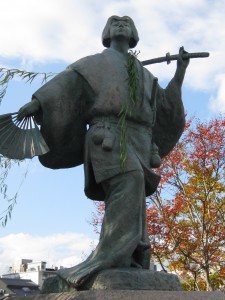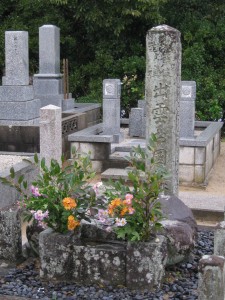
Okuni's statue in Kyoto showing her impersonating a samurai
Izumo no okuni was the daughter of a blacksmith who started out as a miko (shrine maiden) at Izumo Shrine. She was known for her beauty and her skill at performing sacred dance (kagura). She was therefore chosen to be sent to Kyoto to raise money for the shrine, as was the custom of the age. Priests and other shrine personnel had to act as fund-raisers.
The freedom she found in the capital must have gone to Okuni’s head, for she soon turned from sacred dance to the profane. She started performing on the dry river bank of the Kamogawa, and her sensual style of dance attracted large crowds. She added humorous skits satirising the manner of lovers, and she even impersonated samurai and prostitutes. Though she sent money back to Izumo, the shrine authorities were concerned by her reputation and summoned her home. She refused.
By the time that Tokugawa Ieyasu was declared shogun in 1603, Okuni had gathered together a troupe whose performances were called ‘kabuki’ or crazy. The song and dance routines were done in colourful costumes, so as to please the eye as well as the ear. Interestingly, in complete distinction to today’s kabuki, Okuni’s troupe were all female.
(Because of concern about women using the stage to advertise themselves, the shogun banned women from kabuki in 1629. Thereafter, as on the Elizabethan stage, young boys played the part of women, though this was too was soon banned because of immorality. You just can’t win with lust!)
Okuni had a patron, Ujisato Sanzauro, who helped give kabuki a more dramatic style. As a result the troupe’s performances became famous – and copied – thoughout the land. Interestingly, this was around the same time that Shakespeare transformed the English stage.

Okuni's grave at Izumo, near the shrine where she once served as a miko
What happened to Okuni in later years is uncertain, and her date of death is unknown. There’s a grave for her in Izumo, so presumably, like Shakespeare, she retired back to her hometown when her career was over. Once a simple shrine maiden, she left her mark on the culture of the nation. From dancing for the gods (kagura), she had gone on to dance her way into history.
Viva Okuni ! We in Kyoto remember you with fondness…

Great article, thanks! Okuni is one of the strongest and most creative women in world history. She must have been a lot of fun to be around! Kabuki fans and people who are interested in learning more about Kabuki and Japanese performing arts should check out the JETAANC Kabuki Club website: http://www.jetaanc.org/kabuki There you can join our international mailing list and discussion group devoted to Kabuki and Japanese performing arts!